
Abu Simbel is a historic site comprising two massive rock-cut temples in the village of Abu Simbel, Aswan Governorate, Upper Egypt, near the border with Sudan. It is situated on the western bank of Lake Nasser, about 230 km (140 mi) southwest of Aswan. The complex is part of the UNESCO World Heritage Site known as the "Nubian Monuments", which run from Abu Simbel downriver to Philae, and include Amada, Wadi es-Sebua, and other Nubian sites. The twin temples were originally carved out of the mountainside in the 13th century BC, during the 19th Dynasty reign of the Pharaoh Ramesses II. They serve as a lasting monument to the king Ramesses II. His wife Nefertari and children can be seen in smaller figures by his feet, considered to be of lesser importance and were not given the same position of scale. This commemorates his victory at the Battle of Kadesh. Their huge external rock relief figures have become iconic.

Menpehtyre Ramesses I was the founding pharaoh of ancient Egypt's 19th Dynasty. The dates for his short reign are not completely known but the time-line of late 1292–1290 BC is frequently cited as well as 1295–1294 BC. While Ramesses I was the founder of the 19th Dynasty, his brief reign mainly serves to mark the transition between the reign of Horemheb, who had stabilized Egypt in the late 18th Dynasty, and the rule of the powerful pharaohs of his own dynasty, in particular his son Seti I, and grandson Ramesses II.

Greek temples were structures built to house deity statues within Greek sanctuaries in ancient Greek religion. The temple interiors did not serve as meeting places, since the sacrifices and rituals dedicated to the respective deity took place outside them, within the wider precinct of the sanctuary, which might be large. Temples were frequently used to store votive offerings. They are the most important and most widespread building type in Greek architecture. In the Hellenistic kingdoms of Southwest Asia and of North Africa, buildings erected to fulfil the functions of a temple often continued to follow the local traditions. Even where a Greek influence is visible, such structures are not normally considered as Greek temples. This applies, for example, to the Graeco-Parthian and Bactrian temples, or to the Ptolemaic examples, which follow Egyptian tradition. Most Greek temples were oriented astronomically.
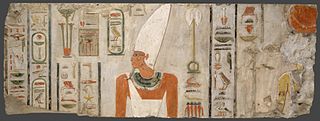
Mentuhotep II, also known under his prenomen Nebhepetre, was an ancient Egyptian pharaoh, the sixth ruler of the Eleventh Dynasty. He is credited with reuniting Egypt, thus ending the turbulent First Intermediate Period and becoming the first pharaoh of the Middle Kingdom. He reigned for 51 years, according to the Turin King List. Mentuhotep II succeeded his father Intef III on the throne and was in turn succeeded by his son Mentuhotep III.

The Temple of Ramesses III at Medinet Habu was an important New Kingdom period temple structure in the West Bank of Luxor in Egypt. Aside from its size and architectural and artistic importance, the mortuary temple is probably best known as the source of inscribed reliefs depicting the advent and defeat of the Sea Peoples during the reign of Ramesses III.
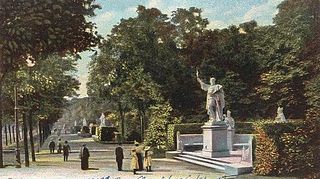
The Siegesallee was a broad boulevard in Berlin, Germany. In 1895, Kaiser Wilhelm II ordered and financed the expansion of an existing avenue, to be adorned with a variety of marble statues. Work was completed in 1901.

In the Manethonian tradition, Salitis was the first Hyksos king, the one who subdued and ruled Lower Egypt and founded the 15th Dynasty.

The Temple of Aphaia or Afea is located within a sanctuary complex dedicated to the goddess Aphaia on the Greek island of Aigina, which lies in the Saronic Gulf. Formerly known as the Temple of Jupiter Panhellenius, the great Doric temple is now recognized as dedicated to the mother-goddess Aphaia. It was a favourite of the Neoclassical and Romantic artists such as J. M. W. Turner. It stands on a c. 160 m peak on the eastern side of the island approximately 13 km east by road from the main port.

The National Museum of Sudan or Sudan National Museum, abbreviated SNM, is a two-story building constructed in 1955 and established as a museum in 1971. The building and its surrounding gardens house the largest and most comprehensive Nubian archaeological collection in the world including objects from the Paleolithic through to the Islamic period originating from every site of importance in the Sudan.
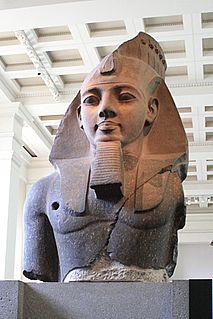
Ramesses II, commonly known as Ramesses the Great, was the third pharaoh of the Nineteenth Dynasty of Egypt. Along with Thutmose III he is often regarded as the greatest, most celebrated, and most powerful pharaoh of the New Kingdom, itself the most powerful period of Ancient Egypt.

The Kingdom of Kush was an ancient kingdom in Nubia, centered along the Nile Valley in what is now northern Sudan and southern Egypt.

Karl Richard Lepsius was a pioneering Prussian Egyptologist, linguist and modern archaeologist.

Abu Simbel is a village in the Egyptian part of Nubia, about 240 km (150 mi) southwest of Aswan and near the border with Sudan. As of 2012, it has about 2600 inhabitants. It is best known as the site of the Abu Simbel temples, which were built by King Ramses II.

The Twenty-fifth Dynasty of Egypt, also known as the Nubian Dynasty, the Kushite Empire, the Black Pharaohs, or the Napatans, after their capital Napata, was the last dynasty of the Third Intermediate Period of Egypt that occurred after the Nubian invasion.
The Kulubnarti church is an archaeological site and former Christian church located on the island of Kulubnarti, in the village of Kulb in northern Sudan. The island is situated between the 2nd and 3rd cataracts of the Nile, about 120 kilometres (75 mi) southwest of Wadi Halfa, in the Batn-El-Hajar region.
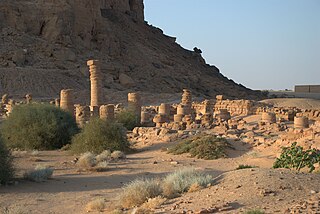
The Temple of Amun is an archaeological site at Jebel Barkal in Northern State, Sudan. It is situated about 400 kilometres (250 mi) north of Khartoum near Karima. The temple stands near a large bend of the Nile River, in the region that was called Nubia in ancient times. The Temple of Amun, one of the largest temples at Jebel Barkal, is considered sacred to the local population. Not only was the Amun temple a main centre of what at one time was considered to be an almost universal religion, but, along with the other archaeological sites at Jebel Barkal, it was representative of the revival of Egyptian religious values. Up to the middle of the 19th century, the temple was subjected to vandalism, destruction, and indiscriminate plundering, before it came under state protection.
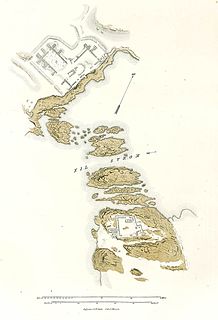
Kumma or Semna East is an archaeological site in Sudan. Established in the mid-12th Dynasty of Egypt, it served as a fortress of ancient Egypt in Nubia. Along with Semna, Kumma was built by the Pharaoh Sesostris III. The forts protected the border between ancient Egypt and the southern areas.

The Book of Nut is a collection of ancient Egyptian astronomical texts, also covering various mythological subjects. These texts focus on the cycles of the stars of the decans, the movements of the moon, the sun, and the planets, on the sundials, and related matters.
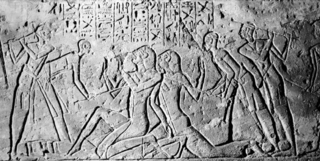
The Kadesh inscriptions or Qadesh inscriptions are a variety of Egyptian hieroglyphic inscriptions describing the Battle of Kadesh. The combined evidence in the form of texts and wall reliefs provide the best documented description of a battle in all of ancient history.

The International Campaign to Save the Monuments of Nubia was the relocation of 22 monuments in Egypt and Sudan, between 1960 and 1980. The success of the project, in particular the creation of a coalition of 50 countries behind the project, led to the creation 1972 World Heritage Convention, and thus to the modern system of World Heritage Sites.



















